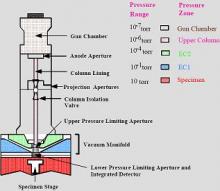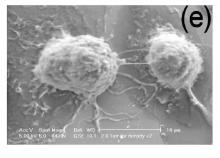Conventional Scanning Electron Microscopy (SEM) can provide misleading information on naturally hydrated systems; hence developing Environmental Scanning Electron Microscopy (ESEM) is very important for such systems. There are many open questions about image formation, optimisation of detectors and experimental design.
In addition, the group operates a dual beam instrument which permits in situ sectioning through samples using a focused ion beam. The group is developing protocols to enable precision sectioning of insulating - and therefore challenging - samples. This requires a combination of practical skills and understanding of the underlying ion and electron physics and the way the beams interact with different kinds of samples.
In relation to cell bio-physics, the group has been exploring myelination by oligodendrocytes; bacteria and infection; the dynamics of leaf stomata opening and closing; macrophage structure; and cell-substrate interactions.
The group is exploring the use of a Wet Scanning Transmission Electron Microscopy detector in the ESEM, which might enable imaging when the whole cell is still immersed in water. Studies suggest the loss of mammalian cell viability is mainly associated with membrane collapse when the surrounding water layer is removed; plant and bacterial cells seem more resistant and ongoing efforts are directed to pushing the study of living cells of these types, and dynamic processes.


